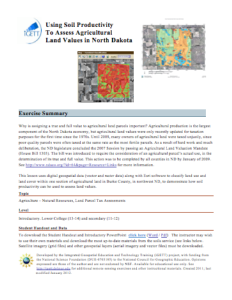Using Soil Productivity To Assess Agricultural Land Values in North Dakota

This exercise, from the Integrated Geospatial Education and Technology Training Project (iGETT), uses digital geospatial data (vector and raster data) along with Esri software to classify land use and land cover within one section of agricultural land in Burke County, North Dakota to demonstrate how soil productivity can be used to assess land values. The lesson contains an Introductory PowerPoint and a six-part exercise.
The exercises stem from agricultural changes brought about by the passing of North Dakota's Agricultural Land Valuation Mandate (House Bill 1301), which requires the consideration of an agricultural parcel's actual use, in the determination of its true and full value. Completion of the exercise, which should take between two-to-three weeks of a three-semester hour class, requires ArcGIS with Spatial Analyst Extension and Service Pack 4 and access to the Internet or a computer lab.
By the end of the lesson, students should be able to describe the functionality of ArcGIS for land use classifications; explain the components of geospatial data models; critically evaluate and articulate how government entities and the National Resources Conservation Service use GIS for identification of geospatial careers; and preform geospatial analysis (geographic inquiry) using a variety of data formats including vector, raster, and image files.
About this Resource


Comments